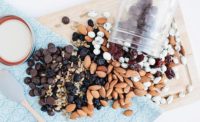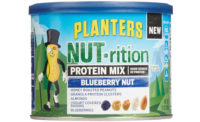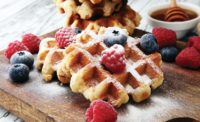Healthier ingredients, bolder tastes and more convenient, on-the-go formats are top trends in the snack bar category. This healthier mindset has brought an emphasis on higher protein, along with and lower carbs, higher fiber and a cleaner label.
Overview | Bread | Tortillas | Sweet Goods | Snack Cakes | Pizza | Desserts | Cookies | Buns & Rolls | Bars | Breakfast Products
Market data
Sales in the overall snack and granola bars category grew modestly for the 52 weeks ending March 25, 2018, up 1.56 percent in dollar sales to $6.14 billion, according to IRI, Chicago.
The nutritional/intrinsic health value bars subcategory was up 2.34 percent to $3.10 billion. CLIF Bar dominates the segment, up 4.37 percent to $792.7 million. Atkins Nutritionals saw strong growth, up 14.85 percent to $199.7 million. But the big news in the segment is relative newcomer RXBAR, up 763.03 percent to $69.1 million for the year. Kellogg Co. acquired the clean-label bar brand for $600 million in 2017.
Sales of breakfast/cereal/snack bars grew the most of any subcategory, up 3.75 percent to $1.3 billion. Kellogg Co. leads the segment by a wide margin at $615.4 million in sales, but dropped off a bit, down 4.62 percent, per IRI. Its line of Special K Nourish bars has seen good growth, up 462.5 percent to $26.8 million. The Small Planet Foods/General Mills brand LÄRABAR continues to perform well, up 29.52 percent to $166.4 million. Private label brands were also on the uptick, growing 17.65 percent to $117.4 million, while KIND grew 41.63 percent to $78.6 million in the segment.
Granola bars tailed off slightly, down 0.41 percent to $1.7 billion. General Mills continues to rule the segment, up 8.32 percent to $762.3 million. Its core Nature Valley brand sits in the No. 1 slot for all granola bar brands and saw sales climb 11.97 percent to $468.5 million. The Natural Valley Sweet & Salty line grew 2.31 percent to $281.8 million.
Looking back
Jeannie Swedberg, director of business development, Tree Top, Selah, WA, notes an increase in pressed fruit and nut pressed bars over the past two years. “And activity doesn’t appear to be slowing. Every day seems to bring a new ingredient, flavor, format or label claim.” She points to defining product dynamics like meat, organic, vegan, non-GMO, refrigerated, probiotics and ancient grains. “All the same trends seen in the wider food and beverage industry are reflected in the bar segment, and that includes simple, recognizable ingredients on the label and in the package—fruits, nuts, seeds, vegetables.”
Snack bar consumers continue to seek healthy ingredients, with an increased focus on protein and fiber content, says Giller Maller, vice president, sales and international, Clextral, Firminy, France. “Consumers are eating snack bars as a meal replacement or to refuel after a workout. They are looking for nutritious and guilt-free snack options that are portable and easy to eat, and of course have delicious taste.”
Snack bar makers have broadened their protein sources beyond the old standby of nuts to include plant-based proteins that also offer high fiber and lower fat, Maller says. Clextral has worked with high-protein, high-fiber flours like spelt, teff and farro, he notes, and the company currently makes two styles of snack bars: filled bars with a grain-based, crisp outer shell and soft filling, and snack bars with inclusions with crunchy or soft textures that add variety, flavor and nutritional benefits.
In addition, Clextral has seen snack bites gaining in popularity, mostly in the co-extruded realm, where the company has been developing bites with crispy shells and soft fillings, Maller says. “Extrusion technology is a great tool to leverage local sources of cereals and/or proteins to be incorporated in bars.”
Jörg Hartwig, sales manager, Bosch Packaging Technology, Stuttgart, Germany, sees trends toward healthier granola bars and a boom in “functional bars” deriving from sports nutrition that have an emphasis on protein content. “We see more and more small-sized companies growing up, which have more individual bars. We see more organic bars with special shapes and special tastes.”
Hartwig also has seen a trend toward nut-free bars. “Customers have one factory making standard granola bars, and then a separate factory that just does nut-free bars,” he says. “That’s a trend due to allergies.”
Hearthside Food Solutions, Downers Grove, IL, sees protein as a longer-term trend and low-carb as emerging more recently, says Robert Scalia, senior vice president of strategy and development. Proteins include whey and meat, as well as vegan plant proteins and legumes.
Makers of nutritional bars are “striving for the absolute cleanest label you can get,” says Scalia. “That’s where a bar like RXBAR has made its mark.” Snack bars, he adds, are still more focused on taste, which is why they use nut butter for proteins rather than whey, for example. “Their goal is to get cleaner labels, not the cleanest. We’re also seeing a little bit of a trend moving toward more indulgence.”
The snack bar category also has moved toward greater convenience, Scalia says. “We’re seeing a big push for bites, poppable pieces, on-the-go pieces, as well as single-serve formats vs. traditional retail formats.” And fruit-based bars like KIND are doing well. “You’re seeing more fruit as the carrier, instead of crisps and proteins.”
Molly Spence, director of North America, Almond Board of California, Modesto, notes product developers are diversifying away from traditional cereal bars into cold-formed, baked or multi-layered bars. “As consumers look to snack products to provide on-the-go fuel, or even replace a meal, we are seeing product developers innovate with unique flavors and formats to ensure their bar formulation stands out. Additionally, they are including ingredients, like almonds, that bring nutrition, texture and flavor to satiate consumers.”
Jennifer Tesch, chief marketing officer, Healthy Food Ingredients, Fargo, ND, cites clean label, fewer ingredients, gluten-free, organic, non-GMO, raw and less-processed ingredients, the use of plant-based proteins like pulses, and on-the-go snacking as key trends that intersect with snack bars.
“Our signature product, Suntava Purple Corn, is an innovative, eye-catching ingredient that fits well into the snack bar category,” Tesch says. “We offer it as non-GMO or certified organic in whole, raw form, as well as flour, meal, grits and a recently launched flaked format, which are easily incorporated into the snack bar application.”
Looking forward
In the coming year, Scalia expects to see plant-based proteins and fruit- and vegetable-based products doing well, along with a greater emphasis on hot, spicy, bold flavors. “We’re seeing a couple products that have ghost peppers,” he says. “I would bet on probiotics, and ingredients that have positive nutrition.” He recommends ingredients that focus specifically on segments like immune, cardiovascular and digestive health.
To this end, Scalia believes that bars seen as niche, health-focused products will become more mainstream. “If you’re not focused on the hard-core functional benefit of something, you’ve got to deliver on taste. That’s where the big players are playing. Emerging players are playing on functionality. Functionality will become part of the mainstream. Trying to merge the two—taste and functionality—will be the grail.”
Hartwig predicts a continued trend toward bite-sized, 1-inch-square bars, as well as more rounded bars, which could be packaged two or three to a unit. He also expects to see more savory offerings, and increases in fruit-based bars. “Then, of course, the multifunctionals—typical protein bars for sports—will increase,” he says.
Maller expects to see a continued trend toward health-conscious consumer choices, along with a heightened interest in vegan snacks. “Yet, even when looking for guilt-free snacks, I feel consumers will continue to choose snacks that have the flavors, shapes and marketing that makes snacking a fun experience.”
The Almond Board of California predicts bar makers will continue to use almond butter as a solution to bind bars while adding flavor and nutrition. “The opportunities in the snack bar category are immense, as consumers seek new and innovative products that deliver on convenience, nutrition and taste,” Spence says. “We are seeing huge growth in the number of bars featuring almond butter, as it provides great nutritional value along with a premium feeling.”
Tesch expects snack bar makers will continue to strive for better-for-you and on-the-go snacks. “We continue to engage interest from R&D professionals looking for new, innovative and on-trend ingredients for their products. Using fewer ingredients and having the transparency of a clean label, manufacturers will continue to work within those categories to offer snack bars that are also functional to meet consumer demand.”
Overview | Bread | Tortillas | Sweet Goods | Snack Cakes | Pizza | Desserts | Cookies | Buns & Rolls | Bars | Breakfast Products









